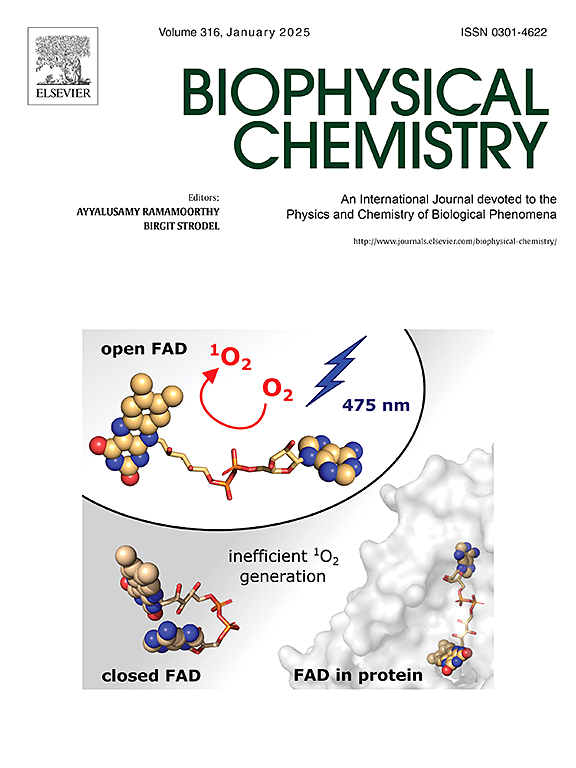替莫唑胺通过脑质膜时局部有序性的影响
IF 2.2
3区 生物学
Q2 BIOCHEMISTRY & MOLECULAR BIOLOGY
引用次数: 0
摘要
替莫唑胺是一种小分子药物,主要用于治疗胶质母细胞瘤,这是一种同时攻击脊髓和大脑的肿瘤。了解替莫唑胺如何在原子水平上与细胞膜内的不同脂质相互作用,有助于阐明其通过细胞膜渗透的能力。在这项研究中,我们构建了一个简化的脑质膜模型,利用全原子微秒尺度的分子动力学模拟来探索替莫唑胺的微观结构和动力学。替莫唑胺通常存在于脑膜周围的溶剂-水溶液中,但它可以定期进入膜界面,并最终与胆碱类和脑苷类脂结合。为了研究替莫唑胺的自由能垒与它穿过类脑质膜的关系,我们采用了自适应偏置力方法。这些模拟结果表明,在310 ~ 323 K的温度下,自由能势垒在28 ~ 50 kcal/mol之间。我们的研究结果表明,在正常体温下,替莫唑胺不能通过纯扩散穿过膜,但温度升高会显著增加穿越屏障的可能性。这主要是由于胆固醇和脑苷类脂质所起的关键作用。这些结果可用于优化替莫唑胺的分子设计和开发具有更好药动学性质的新类似物。本文章由计算机程序翻译,如有差异,请以英文原文为准。

Influence of local ordering in the permeation of Temozolomide through the brain plasmatic membrane
Temozolomide, a small-molecule drug, is primarily used to treat glioblastoma, a tumor that attacks both the spinal cord and brain. Understanding how Temozolomide interacts with different lipids within the brain cell membrane at the atomic level can help elucidate its ability to permeate through cell membranes. In this study, we constructed a simplified brain plasma membrane model to explore the microscopic structure and dynamics of Temozolomide using all-atom microsecond-scale molecular dynamics simulations. Temozolomide is typically found in the solvent-aqueous fluid surrounding the brain membrane, but it can access the membrane interface regularly and eventually bind to lipids of the choline and cerebroside classes. To investigate the free energy barriers of Temozolomide related to its crossing of brain-like plasma membranes, we employed adaptive biasing force methods. These simulations revealed that the free energy barriers ranged between 28 and 50 kcal/mol at temperatures between 310 K and 323 K. Our findings suggest that Temozolomide cannot cross the membrane by pure diffusion at normal human body temperature, but that rising the temperature significantly increases the probability of barrier crossing. This is primarily due to the crucial role played by cholesterol and lipids of the cerebroside class. These results can be used to optimise the molecular design of Temozolomide and develop new analogs with improved pharmacokinetic properties.
求助全文
通过发布文献求助,成功后即可免费获取论文全文。
去求助
来源期刊

Biophysical chemistry
生物-生化与分子生物学
CiteScore
6.10
自引率
10.50%
发文量
121
审稿时长
20 days
期刊介绍:
Biophysical Chemistry publishes original work and reviews in the areas of chemistry and physics directly impacting biological phenomena. Quantitative analysis of the properties of biological macromolecules, biologically active molecules, macromolecular assemblies and cell components in terms of kinetics, thermodynamics, spatio-temporal organization, NMR and X-ray structural biology, as well as single-molecule detection represent a major focus of the journal. Theoretical and computational treatments of biomacromolecular systems, macromolecular interactions, regulatory control and systems biology are also of interest to the journal.
 求助内容:
求助内容: 应助结果提醒方式:
应助结果提醒方式:


